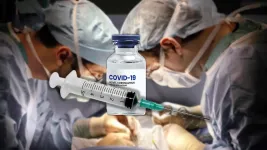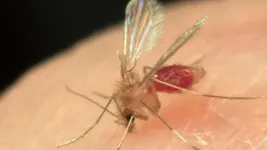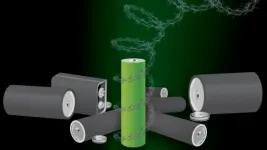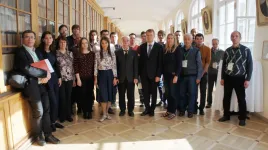Scientists discover how to trick cancer cells to consume toxic drugs
Research could open the doors for a Trojan horse in cancer therapy.
2021-05-06
(Press-News.org) BOSTON - New research led by a team at Massachusetts General Hospital (MGH) points to a promising strategy to boost tumors' intake of cancer drugs, thereby increasing the effectiveness of chemotherapy treatments. The group's findings are published in Nature Nanotechnology.
Getting enough anticancer drugs into a tumor is often difficult, and a potential strategy to overcome this challenge involves binding the medications to albumin, the most abundant protein in blood. The strategy relies on tumors' large appetite for protein nutrients that fuel malignant growth. When consuming available albumin, the tumors will inadvertently take in the attached drugs.
A popular albumin-bound drug approved by the U.S. Food and Drug Administration is nanoparticle albumin-bound paclitaxel (nab-PTX), and it has been successfully used to treat late-stage lung and pancreatic cancers. "Not all patients respond to nab-PTX, though, and the effectiveness of its delivery to tumors has been mixed, owing to an incomplete understanding of how albumin impacts drug delivery and actions," says senior author Miles Miller, PhD, a principal investigator in the MGH Center for Systems Biology and assistant professor of Radiology at Harvard Medical School.
To provide insights, Miller and his colleagues assessed the delivery of nab-PTX to tumors at a single-cell resolution in mouse models of cancer. Using 3D microscopy and what's called tissue clearing technology, the team found that cancer cells can take up a significant amount of nab-PTX, and that the consumption of these drugs is controlled by signaling pathways that are involved in the cells' uptake of nutrients such as albumin.
"This discovery suggested that if we could manipulate these pathways, we might be able to trick cancer cells into a nutrient-starved state, thereby enhancing their consumption of nab-PTX," explains Ran Li, PhD, first author on the study and an instructor in the MGH Department of Radiology and the Center for Systems Biology. Indeed, treating tumors with an inhibitor of insulin-like growth factor 1 receptor, an important component of one of the signaling pathways, improved the accumulation of nab-PTX in tumors and boosted its effectiveness.
"These results offer new possibilities to improve delivery of albumin-bound drugs in patients with diverse types of cancer," says Miller.
INFORMATION:
Co-senior author Ralph Weissleder, MD, PhD, is director of the MGH Center for Systems Biology. Other co-authors from MGH include Thomas Ng, MD, PhD, Mark Prytyskach, Chris Rodell, PhD, Hannes Mikula, PhD, Rainer Kohler, PhD, Michelle Garlin, MD, Sareh Parangi, MD, Nabeel Bardeesy, PhD, and colleagues at multiple other institutions.
Support for this work was provided by the National Institutes of Health, the National Cancer Institute, the National Science Foundation, the American Cancer Society, the American Thyroid Association and the Thyroid Cancer Survivors' Association.
About the Massachusetts General Hospital
Massachusetts General Hospital, founded in 1811, is the original and largest teaching hospital of Harvard Medical School. The Mass General Research Institute conducts the largest hospital-based research program in the nation, with annual research operations of more than $1 billion and comprises more than 9,500 researchers working across more than 30 institutes, centers and departments. In August 2020, Mass General was named #6 in the U.S. News & World Report list of "America's Best Hospitals."
ELSE PRESS RELEASES FROM THIS DATE:
2021-05-06
How did people living in the Bronze Age manage their finances before money became widespread? Researchers from the Universities of Göttingen and Rome have discovered that bronze scrap found in hoards in Europe circulated as a currency. These pieces of scrap - which might include swords, axes, and jewellery broken into pieces - were used as cash in the late Bronze Age (1350-800 BC), and in fact complied with a weight system used across Europe. This research suggests that something very similar to our 'global market' evolved across Western Eurasia from the everyday use of scrap for cash by ordinary people some 1000 years before the beginning of classical civilizations. The results were published in Journal of Archaeological Science.
This study analysed around ...
2021-05-06
'Natural disasters,' sparked by climate change and other natural hazards, increase the triggers for violence against women and girls by boosting the means, opportunity, and underlying drivers, finds a review of the available evidence, published in the online journal BMJ Global Health.
As these disasters are increasing in frequency, severity, and duration worldwide, this consequence must now be formally recognised in public health, violence prevention, and disaster management strategies, urge the researchers.
Over the past two decades, 7348 ...
2021-05-06
New research from Simon Fraser University suggests that students learning remotely become night owls but do not sleep more despite the time saved commuting, working or attending social events.
The study, led by psychology professor Ralph Mistlberger, Andrea Smit and Myriam Juda, at SFU's Circadian Rhythms and Sleep Lab, compared self-reported data on sleep habits from 80 students enrolled in a 2020 summer session course at SFU with data collected from 450 students enrolled in the same course during previous summer semesters. The study results were recently published in the journal PLOS ONE.
"There is a widespread belief among ...
2021-05-06
In a study published today in the Journal of the American Medical Association (JAMA), Johns Hopkins Medicine researchers show that although two doses of a vaccine against SARS-CoV-2 -- the virus that causes COVID 19 -- confers some protection for people who have received solid organ transplants, it's still not enough to enable them to dispense with masks, physical distancing and other safety measures.
This is a follow-up study to an earlier one published in March in JAMA, in which the researchers reported that only 17% of the participating transplant recipients produced sufficient antibodies after just one dose of a two-dose COVID-19 vaccine regimen.
"While there was an ...
2021-05-06
Loneliness and social isolation have been significant problems for the general population during the COVID-19 pandemic, but for cancer patients these issues were particularly acute, likely due to isolation and social distancing, according to a new UCSF study.
The study, which is the first to evaluate loneliness, anxiety, depression, fatigue and other symptoms in a single group of patients, is published in Cancer, a peer-reviewed journal of the American Cancer Society.
"We found that oncology patients were experiencing a deep sense of loneliness," ...
2021-05-06
Researchers at North Carolina State University and the University of North Carolina Greensboro made a surprising finding while examining areas where sand flies rear their young: a new species of bacteria that is highly attractive to pregnant, or gravid, sand flies. The findings could advance the production of ecologically safe baits or traps to reduce sand fly populations.
Sand flies are vectors for important parasitic diseases affecting people in tropical and subtropical regions in Asia, Africa and the Middle East. One of those diseases is Leishmaniasis, which generally causes ...
2021-05-06
HOUSTON - (May 6, 2021) - A Rice University laboratory has adapted its laser-induced graphene technique to make high-resolution, micron-scale patterns of the conductive material for consumer electronics and other applications.
Laser-induced graphene (LIG), introduced in 2014 by Rice chemist James Tour, involves burning away everything that isn't carbon from polymers or other materials, leaving the carbon atoms to reconfigure themselves into films of characteristic hexagonal graphene.
The process employs a commercial laser that "writes" graphene patterns into surfaces that to date have included wood, paper and even food.
The new iteration writes fine patterns of graphene into photoresist polymers, light-sensitive materials used in photolithography and ...
2021-05-06
As the human body's largest organ, the skin is responsible for protecting against a wide range of possible infections on all fleshy surfaces, from head to toe. So how exactly does the skin organize its defenses against such an array of threats?
A new Yale study shows that the epidermis, the outermost layer of skin, is comprised of an army of immune cells that station themselves at regular intervals across the skin's vast expanse to resist infection. When necessary, the researchers found, these immune system soldiers are able to reposition themselves to protect vulnerable areas.
The study, published in the journal Nature Cell Biology, was conducted by the lab of Valentina ...
2021-05-06
The introduction of lithium-ion (Li-ion) batteries has revolutionized technology as a whole, leading to major advances in consumer goods across nearly all sectors. Battery-powered devices have become ubiquitous across the world. While the availability of technology is generally a good thing, the rapid growth has led directly to several key ethical and environmental issues surrounding the use of Li-ion batteries.
Current Li-ion batteries utilize significant amounts of cobalt, which in several well-documented international cases is mined using child labor in dangerous working ...
2021-05-06
The idea of creating quantum computers has long captured the minds of researchers and experts of IT corporations. They are the most powerful computers operating according to the laws of the quantum world and capable of solving many problems more efficiently than the most productive classical supercomputers. Similar developments are underway, for example, at Google and IBM. However, many such projects require the use of cryostats. These are vessels with liquid nitrogen or compressed helium, inside which quantum processors are cooled to temperatures below -270°C. Such a low temperature is required to maintain the superconductivity effect, which is necessary for the operation ...
LAST 30 PRESS RELEASES:
[Press-News.org] Scientists discover how to trick cancer cells to consume toxic drugs
Research could open the doors for a Trojan horse in cancer therapy.





